Construal and its representative forms in cognitive linguistics
The purpose of this paper is to examine construal as a basic human cognitive operation
and its representative forms in Cognitive Linguistics. To achieve this purpose, the paper
focuses on two main points: (a) a brief introduction to construal and some of its
classification models; (b) an examination of the representative forms of construal which we
often see in the literature of Cognitive Linguistics.
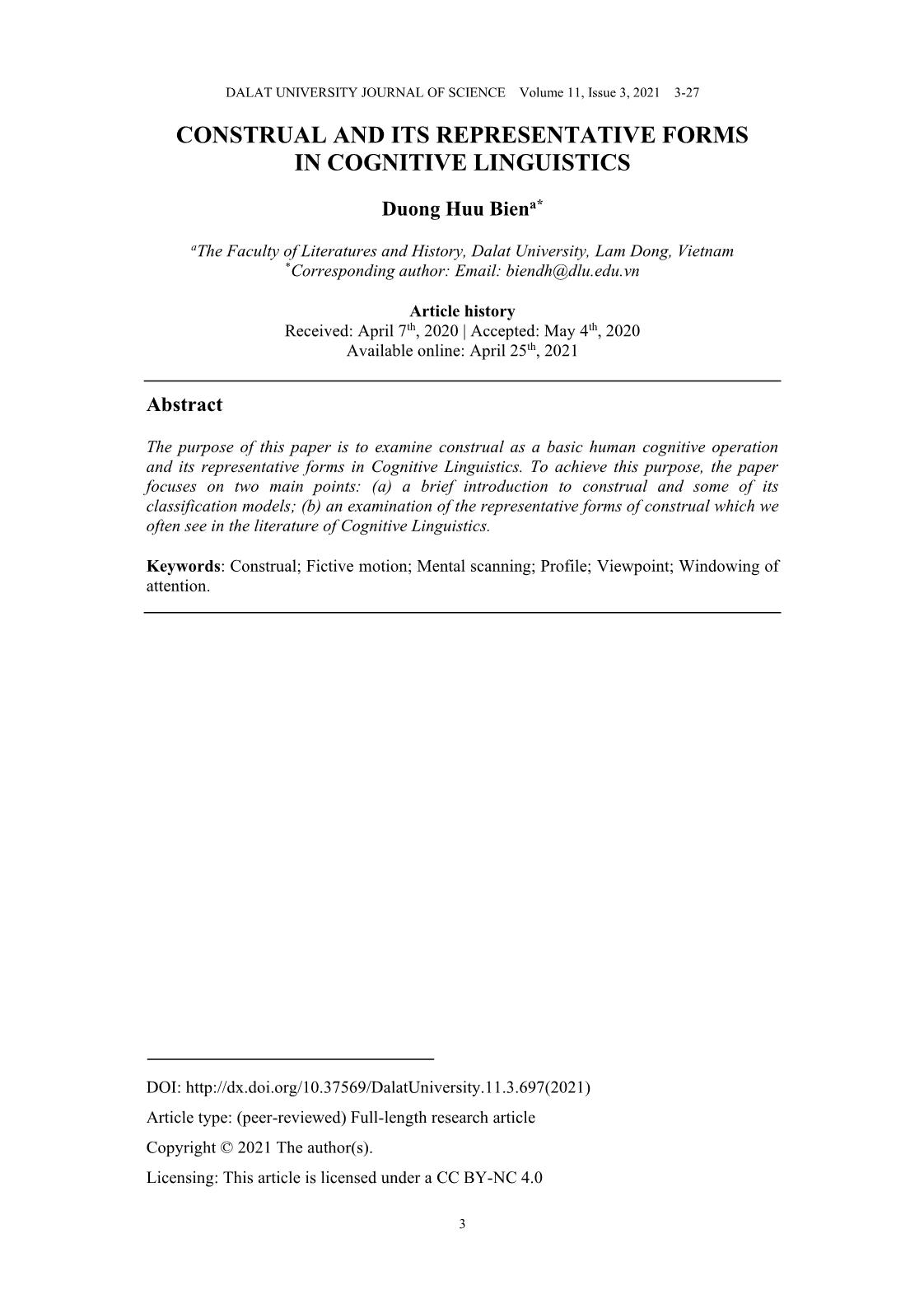
Trang 1
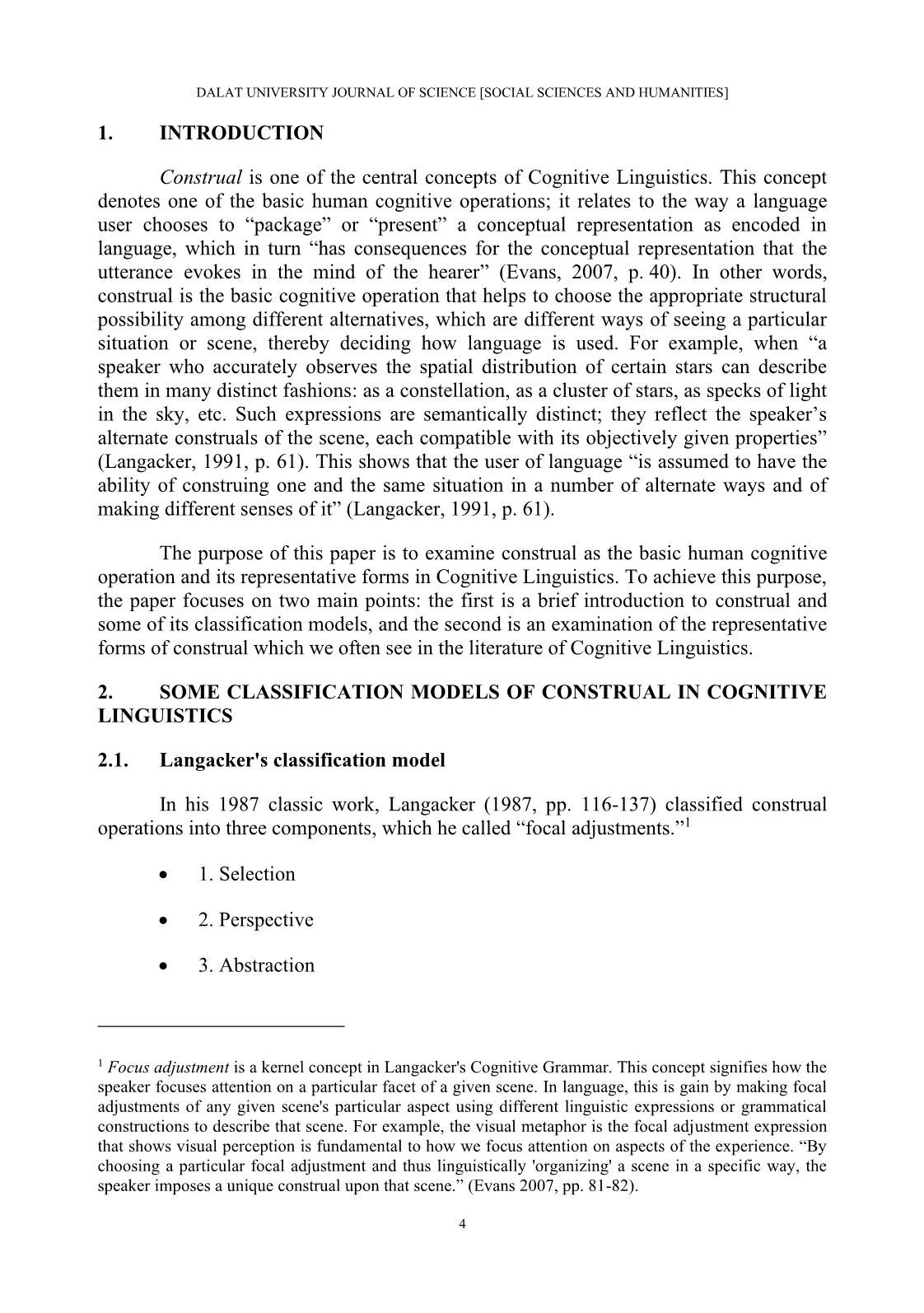
Trang 2
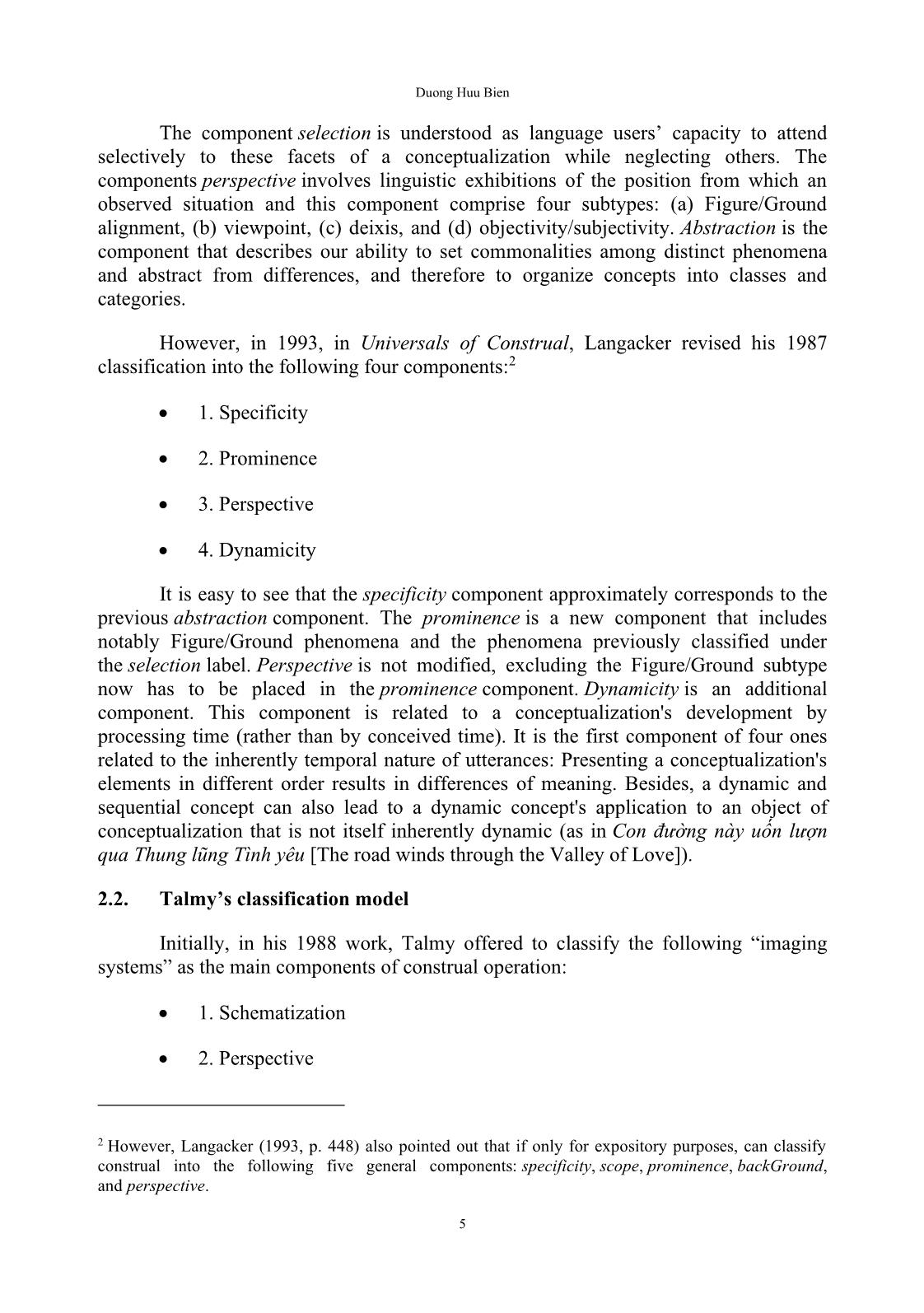
Trang 3
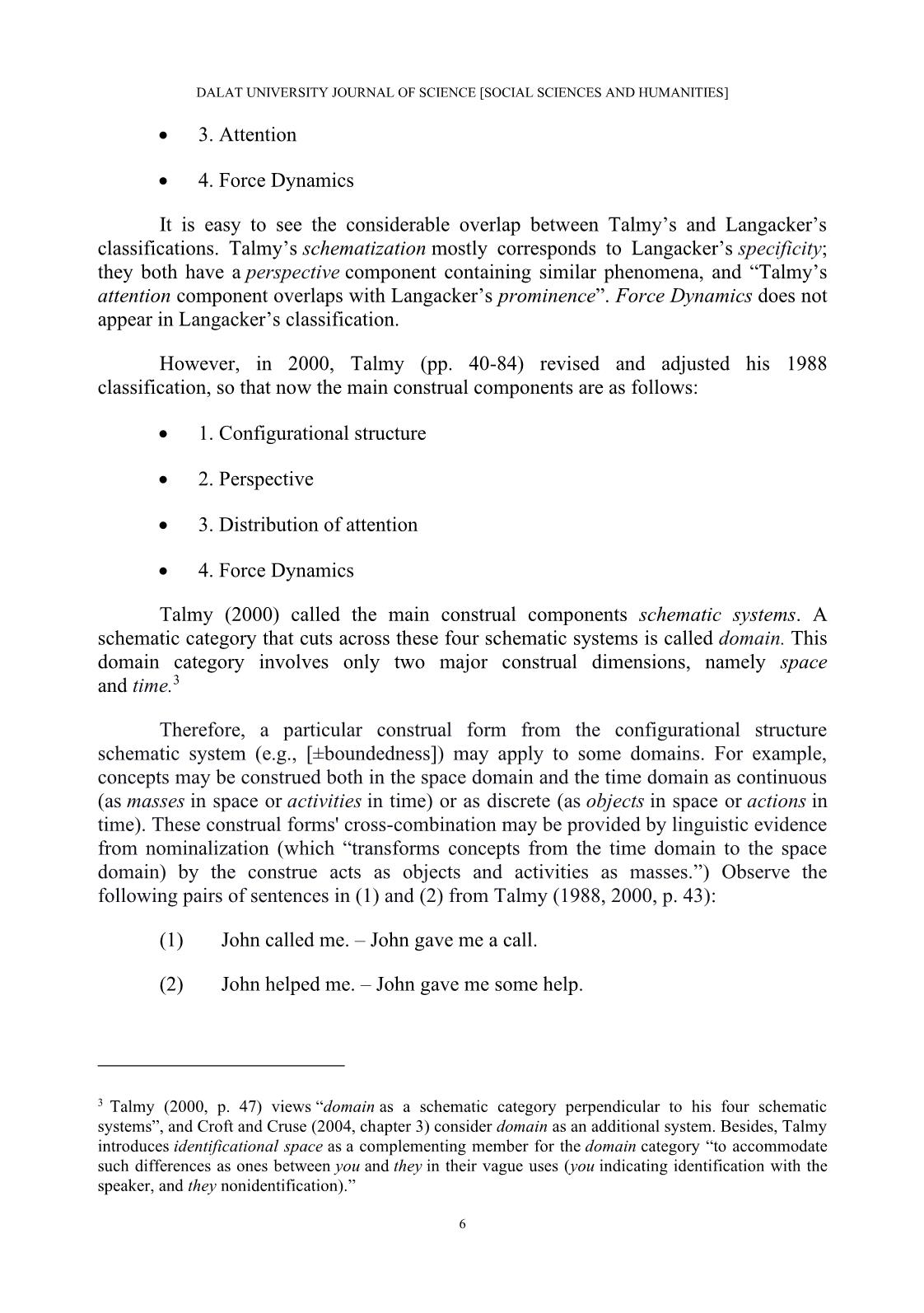
Trang 4
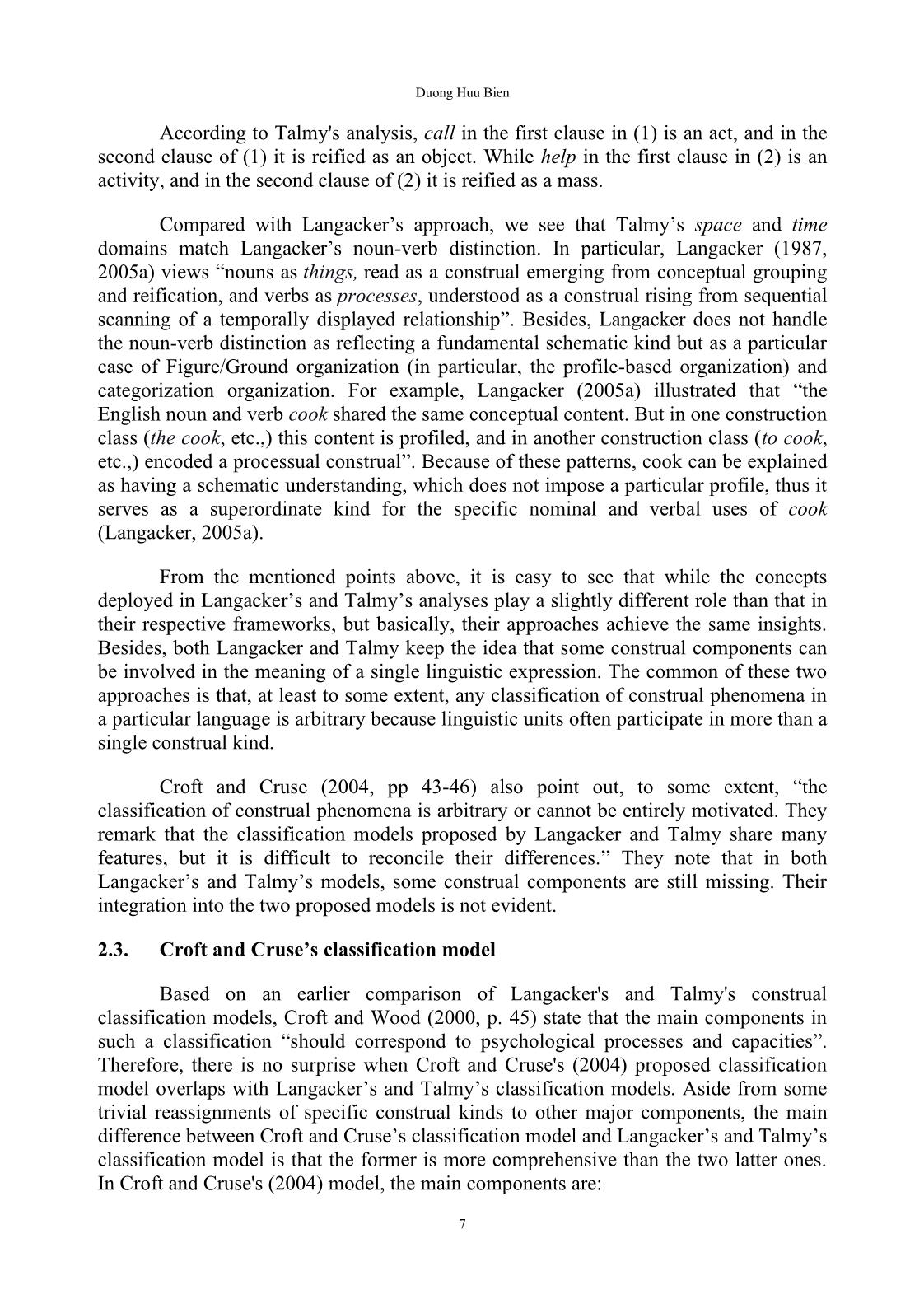
Trang 5
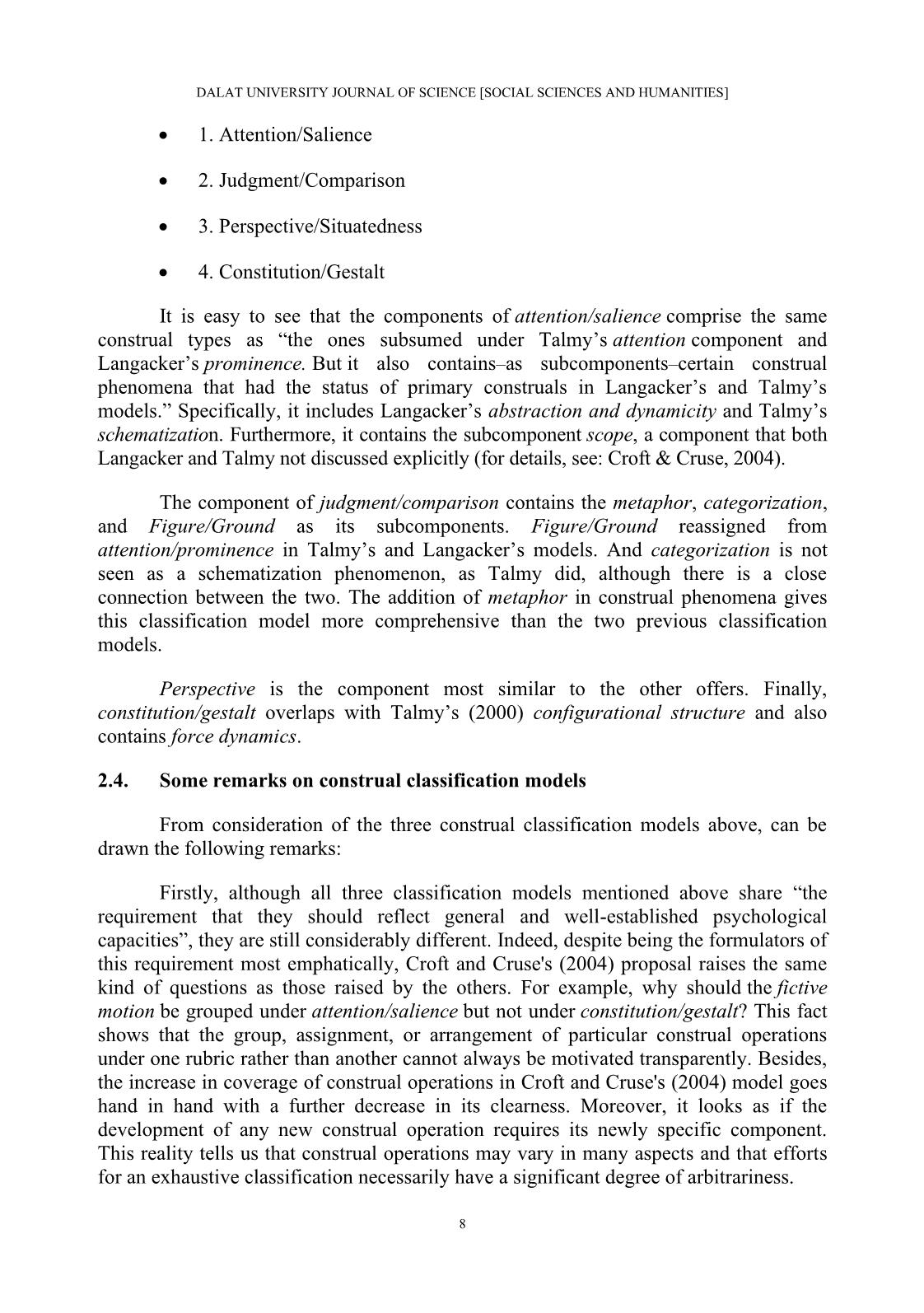
Trang 6
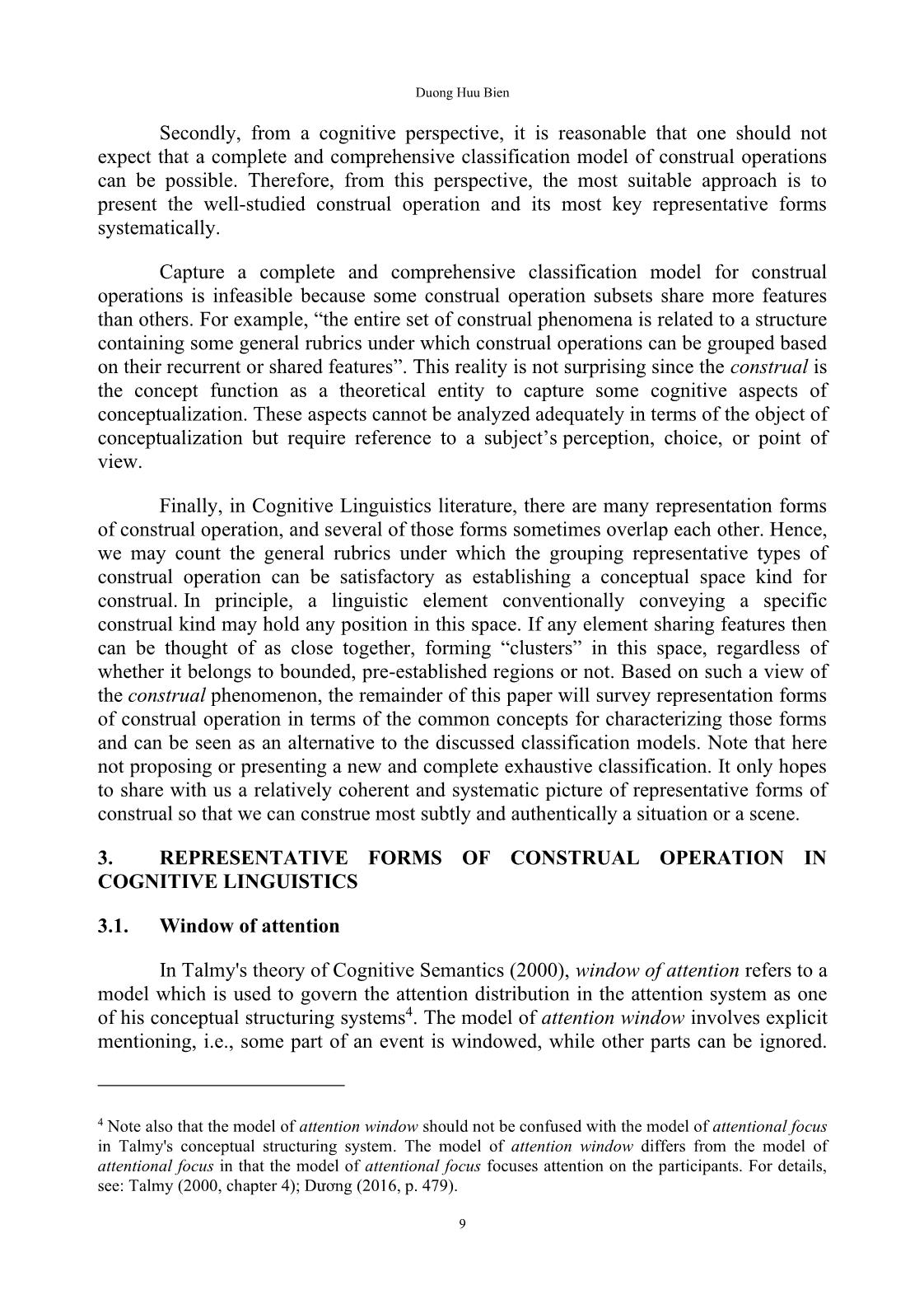
Trang 7
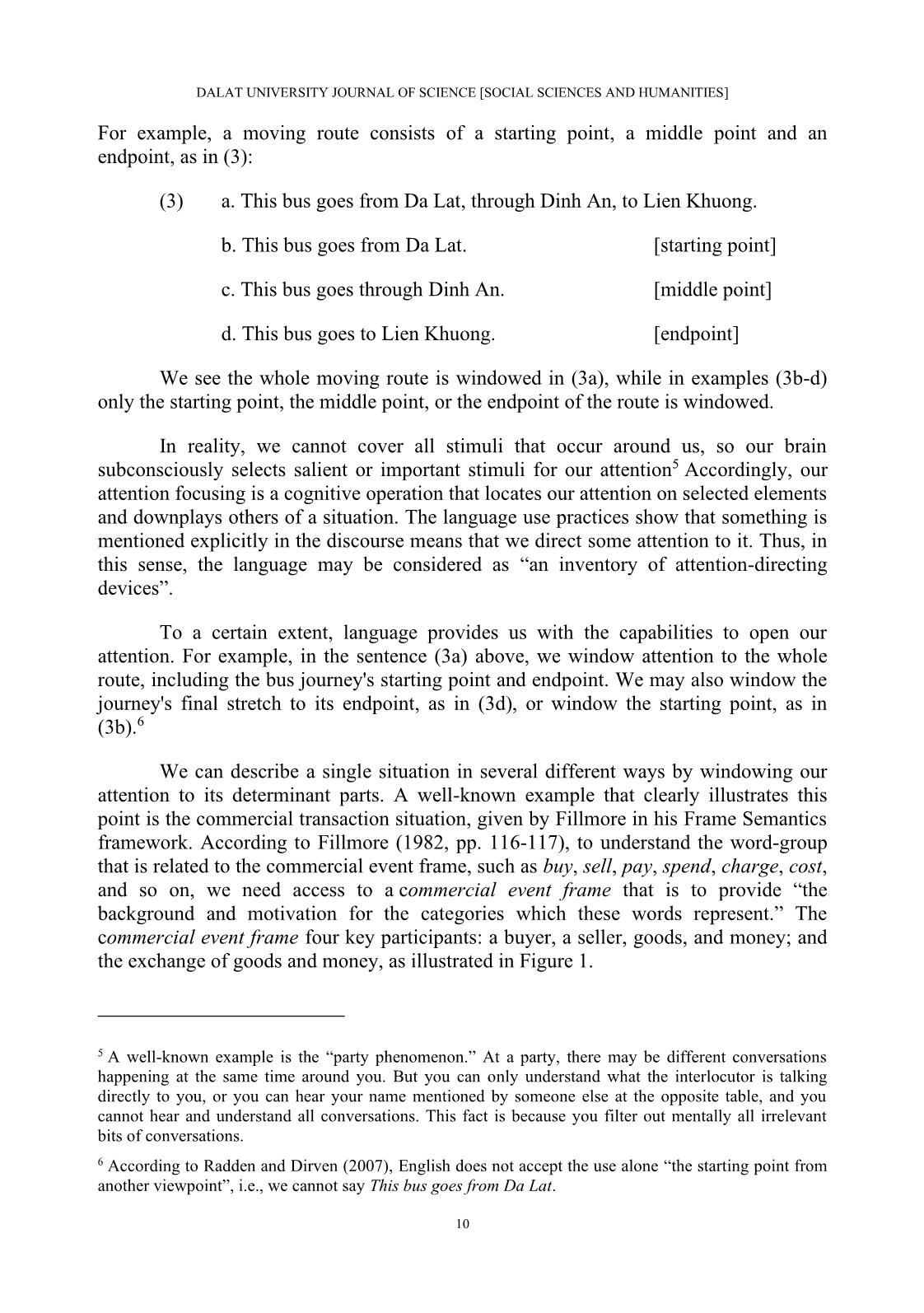
Trang 8
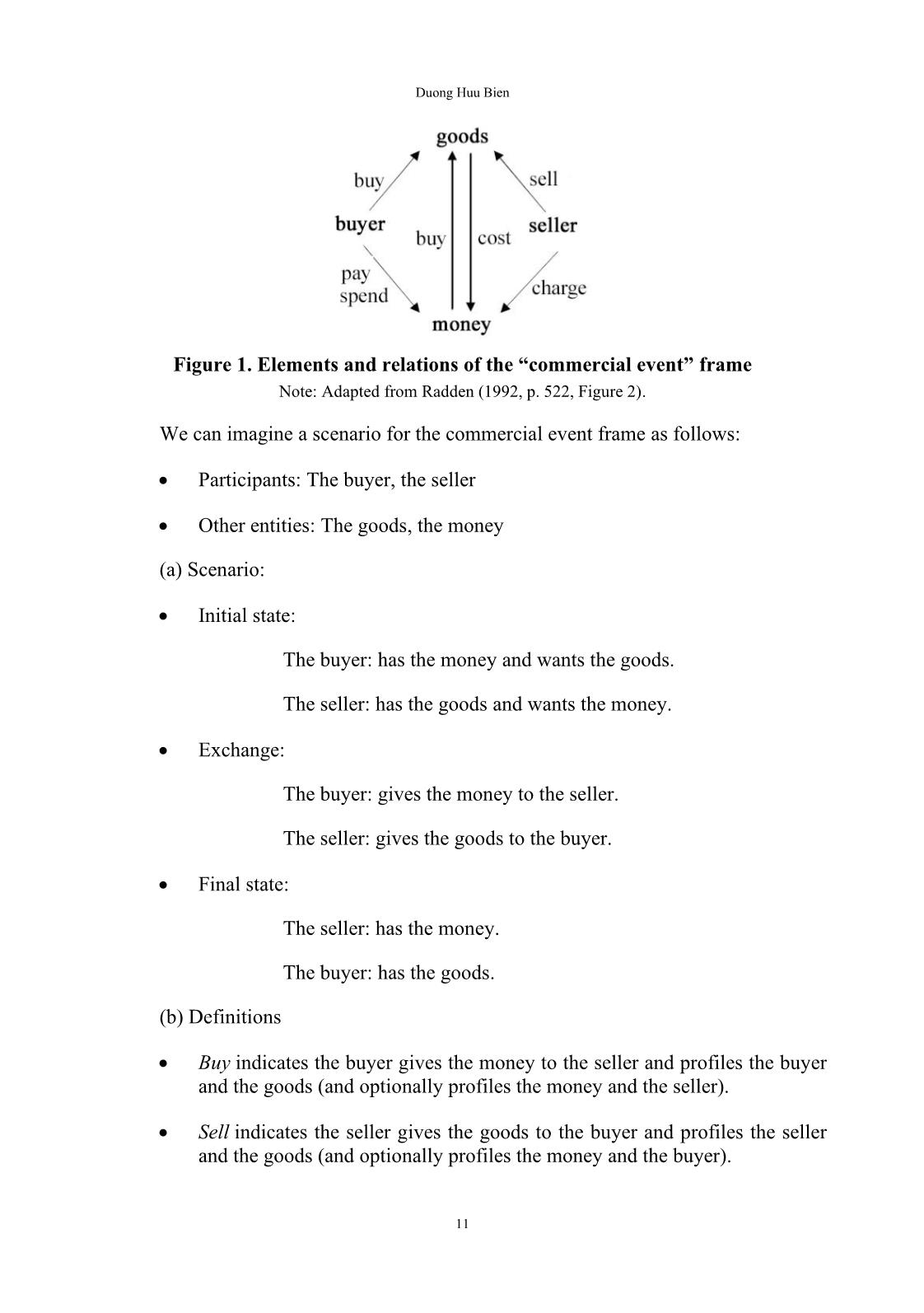
Trang 9
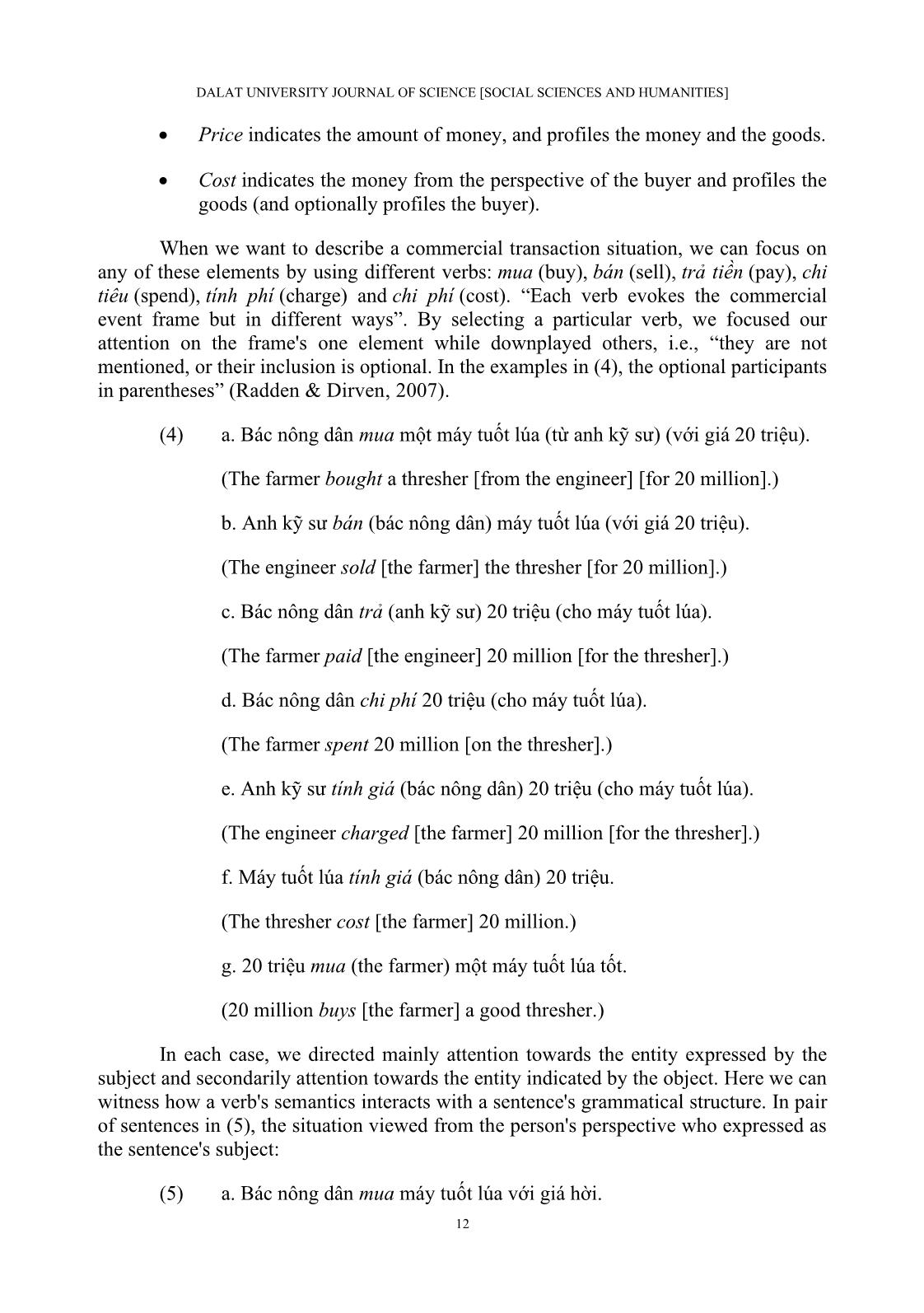
Trang 10
Tải về để xem bản đầy đủ
Bạn đang xem 10 trang mẫu của tài liệu "Construal and its representative forms in cognitive linguistics", để tải tài liệu gốc về máy hãy click vào nút Download ở trên
Tóm tắt nội dung tài liệu: Construal and its representative forms in cognitive linguistics
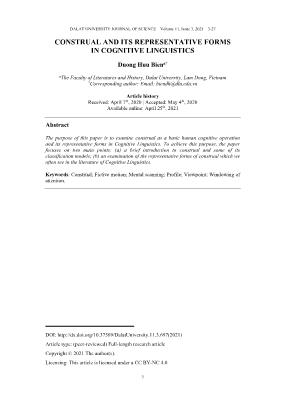
DALAT UNIVERSITY JOURNAL OF SCIENCE Volume 11, Issue 3, 2021 3-27 3 CONSTRUAL AND ITS REPRESENTATIVE FORMS IN COGNITIVE LINGUISTICS Duong Huu Biena* aThe Faculty of Literatures and History, Dalat University, Lam Dong, Vietnam *Corresponding author: Email: biendh@dlu.edu.vn Article history Received: April 7th, 2020 | Accepted: May 4th, 2020 Available online: April 25th, 2021 Abstract The purpose of this paper is to examine construal as a basic human cognitive operation and its representative forms in Cognitive Linguistics. To achieve this purpose, the paper focuses on two main points: (a) a brief introduction to construal and some of its classification models; (b) an examination of the representative forms of construal which we often see in the literature of Cognitive Linguistics. Keywords: Construal; Fictive motion; Mental scanning; Profile; Viewpoint; Windowing of attention. DOI: Article type: (peer-reviewed) Full-length research article Copyright © 2021 The author(s). Licensing: This article is licensed under a CC BY-NC 4.0 DALAT UNIVERSITY JOURNAL OF SCIENCE [SOCIAL SCIENCES AND HUMANITIES] 4 1. INTRODUCTION Construal is one of the central concepts of Cognitive Linguistics. This concept denotes one of the basic human cognitive operations; it relates to the way a language user chooses to “package” or “present” a conceptual representation as encoded in language, which in turn “has consequences for the conceptual representation that the utterance evokes in the mind of the hearer” (Evans, 2007, p. 40). In other words, construal is the basic cognitive operation that helps to choose the appropriate structural possibility among different alternatives, which are different ways of seeing a particular situation or scene, thereby deciding how language is used. For example, when “a speaker who accurately observes the spatial distribution of certain stars can describe them in many distinct fashions: as a constellation, as a cluster of stars, as specks of light in the sky, etc. Such expressions are semantically distinct; they reflect the speaker’s alternate construals of the scene, each compatible with its objectively given properties” (Langacker, 1991, p. 61). This shows that the user of language “is assumed to have the ability of construing one and the same situation in a number of alternate ways and of making different senses of it” (Langacker, 1991, p. 61). The purpose of this paper is to examine construal as the basic human cognitive operation and its representative forms in Cognitive Linguistics. To achieve this purpose, the paper focuses on two main points: the first is a brief introduction to construal and some of its classification models, and the second is an examination of the representative forms of construal which we often see in the literature of Cognitive Linguistics. 2. SOME CLASSIFICATION MODELS OF CONSTRUAL IN COGNITIVE LINGUISTICS 2.1. Langacker's classification model In his 1987 classic work, Langacker (1987, pp. 116-137) classified construal operations into three components, which he called “focal adjustments.”1 • 1. Selection • 2. Perspective • 3. Abstraction 1 Focus adjustment is a kernel concept in Langacker's Cognitive Grammar. This concept signifies how the speaker focuses attention on a particular facet of a given scene. In language, this is gain by making focal adjustments of any given scene's particular aspect using different linguistic expressions or grammatical constructions to describe that scene. For example, the visual metaphor is the focal adjustment expression that shows visual perception is fundamental to how we focus attention on aspects of the experience. “By choosing a particular focal adjustment and thus linguistically 'organizing' a scene in a specific way, the speaker imposes a unique construal upon that scene.” (Evans 2007, pp. 81-82). Duong Huu Bien 5 The component selection is understood as language users’ capacity to attend selectively to these facets of a conceptualization while neglecting others. The components perspective involves linguistic exhibitions of the position from which an observed situation and this component comprise four subtypes: (a) Figure/Ground alignment, (b) viewpoint, (c) deixis, and (d) objectivity/subjectivity. Abstraction is the component that describes our ability to set commonalities among distinct phenomena and abstract from differences, and therefore to organize concepts into classes and categories. However, in 1993, in Universals of Construal, Langacker revised his 1987 classification into the following four components:2 • 1. Specificity • 2. Prominence • 3. Perspective • 4. Dynamicity It is easy to see that the specificity component approximately corresponds to the previous abstraction component. The prominence is a new component that includes notably Figure/Ground phenomena and the phenomena previously classified under the selection label. Perspective is not modified, excluding the Figure/Ground subtype now has to be placed in the prominence component. Dynamicity is an additional component. This component is related to a conceptualization's development by processing time (rather than by conceived time). It is the first component of four ones related to the inherently temporal nature of utterances: Presenting a conceptualization's elements in different order results in differences of meaning. Besides, a dynamic and sequential concept can also lead to a dynamic concept's application to an object of conceptualization that is not itself inherently dynamic (as in Con đường này uốn lượn qua Thung lũng Tình yêu [The road winds through the Valley of Love]). 2.2. Talmy’s classification model Initially, in his 1988 work, Talmy offered to classify the following “imaging systems” as the main components of construal operation: • 1. Schematization • 2. ... ars drove way too fast.) c. Chiếc Inova đâm vào một chiếc xe khác. (A Inova struck another car.) d. Chiếc Ford Ranger Wildtrak 2.0 do một tài xế say rượu lái. (The Ford Ranger Wildtrak 2.0 was driven by a drunk driver.) e. Chiếc Honda Civic 2020 bạc bị kẹp giữa hai xe tải. (The silver Honda Civic 2020 was sandwiched between two lorries.) Each of these alternative expression modes has its specific contextual meaning. For example, the superordinate term phương tiện in (18a) might use in the Departments for Transport or traffic reports. The basic-level term xe is used to describe situations in the most usual and general style, such as in (18b). Car enthusiasts can use subordinate words like Inova or Ford Ranger Wildtrak 2.0. “The same thing may thus be seen in different detail by different people in different situations” (Radden & Dirven, 2007). As Langacker (1987) and Talmy (2000) demonstrated, and as already pointed out, we can use lexical categories to make specific differences, while “using grammatical categories is tended to express very abstract or schematic notions, like those of the present, past, and future time”. And grammar also allows us to distinguish different specificity levels. 3.8. Mental scanning In Langacker’s Foundations of Cognitive Grammar (1987), mental scanning means the construal of a situation concerning its phasing in time (T). In other words, in Duong Huu Bien 23 the same style as that we may visually scan a mountain range, we can do the same with a situation. There are two mental scanning modes: sequential scanning and summary scanning. The mental scanning of that situation in its all successive phases is called sequential scanning. Summary scanning concerns the mental scanning mode in which all periods of that situation are did simultaneously, i.e., that situation understood as timeless. The English sentences in (19) illustrate these two mental scanning modes (Radden & Dirven, 2007, p. 26): (19) a. The couple next door has adopted a baby. b. Another couple down the road wants to adopt a baby, too. c. Adopting a baby can be a joyful experience. d. Older couples cannot apply for the adoption of a baby. According to Radden and Dirven (2007, p. 26), in (19a), “we mentally scan the whole process of adopting a child” as it is happening in time. The sequential scanning is expressed linguistically with tense forms of verbs. In other words, any situation verbalized by “a tensed verb form involves sequential scanning”. In sentence (19a), the present tense verb has invoked sequential scanning of the situation's phases. The three remaining sentences of (19) involve summary scanning. Summary scanning is expressed “linguistically in the lack of tense forms”, i.e., situations whose expressions do not have a tensed verb involve summary scanning. The timelessness of both the infinitive to adopt in (19b) and the gerund adopting in (19c) invokes summary scanning, the noun adoption in (19d) also has this timelessness effect. These two scanning modes illustrated in Figure 7: (a) (b) Figure 7. Sequential scanning (a) and summary scanning (b) Source: Langacker (1987, p. 144). DALAT UNIVERSITY JOURNAL OF SCIENCE [SOCIAL SCIENCES AND HUMANITIES] 24 3.9. Fictive motion According to Talmy (2000, chapter 2), “a pervasive cognitive pattern can be posited in which two different cognitive subsystems in an individual form discrepant representations of the same entity. Furthermore, a third subsystem in the individual assesses one of those representations as more veridical, or ‘factive’, and the other as less veridical, or ‘fictive’.” In particular, language has may “fictive motions,” in which a factively stationary entity is represented as motion. Langacker (2005b, 2008) argues that fictive motion reflects subjective imaginary mental constructions used to talk about the existence of objects in real-life situations. It is a special kind of mental scanning, which is used to reactivate the conceptualized original experiences along an imaginary trajectory. Observe (20) and (21): (20) a. Hàng rào này chạy dích dắc từ đồi cù xuống tận hồ Xuân Hương. (This fence zigzags from the hill to Xuân Hương lake.) b. Hàng rào này chạy dích dắc từ hồ Xuân Hương lên tới tận đồi cù. (This fence zigzags from Xuân Hương lake to the hill.) (21) a. Cổng này dẫn ra vườn. (This gate leads to the garden.) b. Con dốc này đổ dài xuống bến cảng gần cây số. (This slope descends nearly a kilometer to the port.) The meanings of motion verbs like chạy (run), dẫn (lead to), đổ (descend), as these examples show, can be extended semantically to express spatial relations that are neither related to the motion itself nor related to a change of state. The motion's figurative representations are attributed to stative situations, immovable physical objects, or abstract concepts. They all are considered fictive movements (Langacker 2005b, 2008; Talmy 1996, 2000, chapter 2). Fictive motion consists of a series of linguistic expressions in which the physical movements are the basis, and other information is the foreground to convey a visual metaphor. However, in the actual ones, a moving object continuously changes its positions over time, while in fictive motion, we mentally scan an imagined path. For example, in (21a), our eyes mentally track the imagined path from-gate-to-garden, and in (21b), our eyes mentally scan from the slope top down to the port. Talmy (2000, chapter 2) details two of the various types of fictive motions. The first type, which he called coextension paths, is used in static spatial relation expressions, as in example (20). “A ‘coextension path’ depicts the form, orientation, or location of a spatially extended object in terms of a path over the object’s extent” (Talmy, 2000, p. 138). This object is stationary and has no entity passing through the Duong Huu Bien 25 described path; however, it is mean as moving along or throughout its spatial configuration, as in (20) above. According to Talmy, in example (20), one cognitive subsystem in a listener has the world knowledge that the fence is stationary. But another subsystem responds to the literal wording–specifically, the motion words chạy, dích dắc, từ, xuống–to evoke a sense of motion along with the linear extent of the fence that “serves to characterize the fence’s contour and positioning” Talmy (2000, p. 138). A parallel sentence (20b) evokes a sense of motion in the opposite direction. Two these sentences together show how a concept–in this case is that of a sense of directed movement–can be imposed on or assigned to notions of phenomena in the world through linguistic devices (see also Dương, 2016). The second type, which Talmy (1996, 2000) called emanation paths, involves “the fictive conceptualization of an intangible line emerging from a source object, passing in a straight line through space, and terminating on a target object, where factively nothing is in motion” (Talmy, 1996, 2000). This fictive motion type has the following subtypes: • (a) “Demonstrative paths” subtype: “a directed line emerges from the pointed front of a source object” (Talmy, 1996, 2000). This is seen in Mũi tên này chỉ tới/chỉ lui/chỉ rời khỏi thị trấn (The arrow points toward/past/away from the town). • (b) “Radiation paths” subtype: a beam/ray of radiation emanates from a radiant object and terminates on an irradiated object, like Ánh sáng chiếu từ mặt trời vào hang (Light shone from the sun into the cave). According to Talmy (1996, 2000), “it might be claimed that photons do factively emanate from a radiant object, so that fictive motion need not be invoked. However, we do not see photons, so any representation of motion is cognitively imputed.” In another case, considered as a small related subtype–those are shadow paths–none claim the existence of “shadow ons,” and this fictive motion is seen in a sentence like Đèn hắt bóng lên tường (Light shadows on the wall). • (c) “Sensory path” subtype “is represented as moving from the experiencer to the experienced object” (Talmy, 1996, 2000) in a sentence like Tôi nhìn/vào quá khứ/tới tương lai (I looked into/past/future). Such an emanating “line of sight” can also be represented as moving laterally, as distinct from vertical fictive motion, as in the sentence Tôi từ từ nhìn xuống giếng (I slowly looked down into the well). Both of these forms of motion are called axial motion. 4. CONCLUSION Construal, as we have seen, relates to different ways of imagining and portraying a situation, but only one of these alternate ways is selected. Construal and its representative forms are fundamental to language and cognition. They show humans’ DALAT UNIVERSITY JOURNAL OF SCIENCE [SOCIAL SCIENCES AND HUMANITIES] 26 cognitive capacities with clear linguistic reflections, but there seems to be no way to organize all of them into a comprehensive classification system. This article examined construal nine representative forms of construal operation that we often see in the Cognitive Linguistics literature. It is easy to see three of these nine forms: windowing of attention, figure/ground, and profiling are related to prominence, in which windowing of attention denotes selected aspects of a situation focused; “figure and ground indicate the division of that situation into salient and non- salient elements; and profiling represents the speaker’s choosing a conceptual and linguistic unit”, e.g., elbow, thereby implying its base (i.e., “arm.”) Six remaining representative forms are related to viewing operation: viewing-frame refers to the situation or its part which the communicators conceive or perceive; viewpoint denotes the speaker’s perspective of that situation; the distinction between objectivity and subjectivity indicates the extent to which the conceptualizer participates partly in that described situation; the division between generality and specificity applies to the construal of the situation in a more general or specific way; mental scanning shows “the construal of the situation in its phasing in time, and fictive motion refers to the construal” of the static situation as the motion situation. All these representative forms show the diversity of the construal operation. Perhaps, thanks to that, the speaker of language “is assumed to have the ability of construing one and the same situation in a number of alternate ways and of making different senses of it” (Langacker, 1991, p. 61). REFERENCES Croft, W., & Cruse, D. A. (2004). Cognitive linguistics. Cambridge University Press. Croft, W., & Wood, E. (2000). Construal operations in linguistics and artificial intelligence. In L. Albertazzi (Ed.), Meaning and cognition: A multidisciplinary approach (pp. 51-78). John Benjamins. Dương, H. B. (2016). Mô hình hệ thống ý niệm trong hệ hình Ngôn ngữ học Tri nhận. In H. B. Dương (Ed), Ngữ văn và Văn hóa học: Một chặng đường (pp. 466-493). Đại học Quốc gia Thành phố Hồ Chí Minh. Evans, V. (2007). A glossary of cognitive linguistics. Edinburgh University Press. Evans, V., & Green, M. (2006). Cognitive linguistics: An introduction. Edinburgh University Press. Fillmore, C. J. (1982). Frame semantics. In The Linguistic Society of Korea (Ed.), Linguistics in the morning calm (pp. 111-137). Hanshin Publishing Co. Fillmore, C. J. (1997). Lectures on deixis. Cambridge University Press. Langacker, R. W. (1987). Foundations of cognitive grammar: Theoretical prerequisites (Vol 1). Stanford University Press. Duong Huu Bien 27 Langacker, R. W. (1991). Concept, image, and symbol: The cognitive basis of grammar. De Gruyter Mouton. Langacker, R. W. (1993). Universals of construal. Berkeley Linguistics Society,19, 447-463. Langacker, R. W. (2005a). Construction grammars: Cognitive, radical, and less so. In F. J. R. de Mendoza Ibáñez & M. S. P. Cervel (Eds.), Cognitive linguistics: Internal dynamics and interdisciplinary interaction (pp. 101-159). De Gruyter Mouton. Langacker, R. W. (2005b). Dynamicity, fictivity, and scanning: The imaginative basis of logic and linguistic meaning. In D. Pecher, & R. A. Zwaan (Eds.), Grounding cognition: The role of perception and action in memory, language, and thinking (pp. 164-197). Cambridge University Press. Langacker, R. W. (2007). Cognitive Grammar. In D. Geeraerts, & H. Cuyckens (Eds.), The Oxford handbook of cognitive linguistics (pp. 421-462). Oxford University Press. Langacker, R. W. (2008). Cognitive grammar: A basic introduction. Oxford University Press. MacLaury, R. E. (1995). Vantage theory. In J. R. Taylor, & R. E. MacLaury (Eds.), Language and the cognitive construal of the world (pp. 231-276). De Gruyter Mouton. Radden, G. (1992). The cognitive approach to natural language. In M. Pütz (Ed.), Thirty years of linguistic evolution (pp. 513-542). John Benjamins. Radden, G., & Dirven, R. (2007). Cognitive English grammar. John Benjamins. Rubin, E. (1958). Figure and Ground. In D. C. Beardslee, & M. Wertheimer (Eds.), Readings in perception (pp. 194-203). Van Nostrand. (The original text published in 1915). Talmy, L. (1978). Figure and Ground in complex sentences. In J. Greenberg, C. Ferguson, & J. Moravcsik (Eds.), Universals of human language (Vol. 4, pp. 625-649). Stanford University Press. Talmy, L. (1988). The relation of grammar to cognition. In B. Rudzka-Ostyn (Ed.), Topics in cognitive linguistics (pp. 165-205). John Benjamins. Talmy, L. (1996). Fictive motion in language and ‘ception’. In P. Bloom, M. A. Peterson, L. Nadel, & M. F. Garrett (Eds.), Language and space (pp. 211-276). MIT Press. Talmy, L. (2000). Toward a cognitive semantics (Vol. 1). MIT Press.
File đính kèm:
 construal_and_its_representative_forms_in_cognitive_linguist.pdf
construal_and_its_representative_forms_in_cognitive_linguist.pdf

